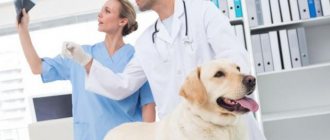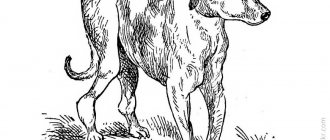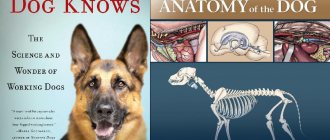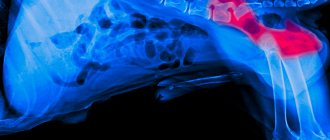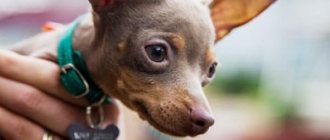Deterioration in gait, joint pain and lameness are the most common consequences of the development of a disease such as arthrosis in dogs. Just like humans, dogs can suffer from arthrosis quite often. Some breeds are more predisposed to it. There is a certain influence of the weight of the animal: in representatives of large breeds, arthrosis is diagnosed more often due to the increased mechanical load on the joints. Treatment will be more successful the sooner the first symptoms are identified and exposure begins. Let's figure out what the causes of this disease in dogs are, how it manifests itself and what treatment measures are most effective.
What is arthrosis in dogs
The disease in question is often confused with arthritis. Despite the similarity in sound and the similarity of some signs of pathology, arthrosis has a number of fundamental differences from arthritis.
With arthrosis, premature wear of the cartilage tissue, which is located inside the joint capsule, is noted. The period of development of the pathology is long, therefore it is detected more often in advanced stages. In such a situation, arthrosis of the joint requires longer recovery and rehabilitation. Therefore, every dog owner should promptly pay attention to disturbing symptoms in his pet and carry out the necessary examinations: this will allow him to quickly restore health and prevent complete destruction of the joints .
What happens with arthrosis
The development of arthrosis is characterized by damage to cartilage tissue cells in a dog. Gradually, in the absence of influence, the negative manifestations intensify, capturing more and more new areas and parts of the joint capsule. As it progresses, both bone tissue and ligaments can be damaged. This entails serious disturbances in the dog’s motor system and can cause lameness and loss of the ability to move normally.
Typically, symptoms of arthrosis in dogs occur when the joints wear out at a certain age. However, they can be observed in case of excessive mobility of the animal during life, with a hereditary tendency to damage joints and ligaments, as well as with significant body weight.
There are two types of arthrosis in dogs. The first is characterized by its occurrence as a result of birth trauma, when congenital damage to the cartilage tissue in the joint is noted. With dysplasia, which also refers to birth injuries, the load on the joint is incorrectly distributed. And this causes uneven wear of cartilage tissue.
Genetic predisposition refers to the first type of disease. This may be a disorder in the chromosomal composition, as a result of which the process of synthesis of cartilage tissue in the body changes, weakness of the ligamentous and tendon apparatus, pathological changes in the condition of the blood vessels that feed the joint capsule.
The following conditions lead to the second type of arthrosis in dogs:
- dislocations, prolapse of the kneecap, sprain and rupture of ligaments;
- hormonal changes. They are caused by aging of the body, pregnancy;
- inflammatory processes in the joints;
- pathologies of the veins, as a result of which the blood supply to the cells and tissues of the joints is disrupted.
Modern research is providing more and more information about the reasons why arthrosis can occur in dogs. To this day, the secondary type of arthrosis is replenished with the symptoms of the disease and the probable causes of its occurrence.
How dangerous is the condition?
The unnoticed development of arthrosis is very dangerous for a pet. Developing gradually, arthrosis is able to “capture” an increasing amount of tissue.
The initial stage of the pathology is characterized by a violation of the integrity of the cartilage tissue of the joint. Gradually, more and more destruction occurs, and with complete thinning, mechanical friction of the bones is noted during the operation of the joint. Most often, this problem occurs in representatives of large breeds.
Lack of exposure in the early stages is dangerous due to the following conditions:
- the occurrence of painful sensations when the animal moves;
- the dog’s gait and its stability change;
- In places of unprotected contact of bone tissue, cracks, grooves and depressions appear. This disrupts the natural structure of the joint capsule and its destruction;
- lameness begins;
- In the later stages of the disease, the dog may lose the ability to move.
The disease can occur gradually, moving from one stage of development to another. However, there is also the manifestation of arthrosis in dogs due to injury, large body weight, and also heredity.
Stages of the disease
According to recent studies, arthrosis occurs due to disturbances in the blood supply to the joint. As a result, there is a pathological change in the condition of bone and cartilage tissue, an imbalance in the cells of cartilage and ligaments.
As you know, arthrosis is a disease with a long course. There are several stages in this disease:
- The first stage is characterized by the appearance of microcracks on the surface of the cartilage tissue. Pathological changes still appear at the cellular level; the pathology has no external manifestations. In this case, there is a significant decrease in the amount of moisture in the cartilage of the joint. And since cartilage tissue contains a large amount of water (60-80%), even a slight loss of it has a noticeable effect on the cartilage.
- At the second stage, the formed grooves in the cartilage tissue deepen, and its separation intensifies. The animal begins to experience pain when moving, externally this can be observed in the form of changes in gait, instability of the dog. The pressure on the bone tissue of the joint increases, and friction occurs when loaded.
- With the transition of the disease to the third stage, a significant change in its behavior occurs: the animal, due to painful sensations when moving, stops actively moving, becomes slower and less stable. The bones begin to rub against each other because the cartilage tissue is completely depleted. Spikes-growths form on it, which cause pain when working the joints. Subsequent progression of the disease leads to the entry of cartilage fragments into the interarticular space and provokes the development of the inflammatory process. If the owner has not taken any therapeutic measures by this time, then there is a high probability of complete immobility of the affected joint - ankylosis.
The joint damage in question has a specific localization. The joints most often affected by arthrosis are the knees, shoulder joints, joints of the hind limbs, and elbow joint. Arthrosis of the hip joint is also diagnosed.
Description of the disease
There are many joints in a dog’s body, each of which has a different structure, depending on its location and function. The structure of any joint contains:
- cartilage;
- synovial fluid;
- joint capsule.
The mechanisms for the development of inflammation in joints are different, depending on the type of arthritis.
The bottom line is that joint deformation occurs due to the growth of granulation tissue in the synovial fluid (which washes and protects the cartilage). Granulation tissue eventually destroys the cartilage down to the bones.
Causes of pathology
The most common causes of pathology include:
- hormonal changes that occur due to aging and pregnancy;
- with significant weight;
- in the presence of a hereditary tendency;
- after injuries, dislocations, sprains.
The listed reasons are primary. Poor blood supply to the joint capsule and lack of calcium in the animal’s diet, especially at a young age, are considered secondary. Inflammatory processes in tissues and joints (for example, arthritis) provoke a deterioration in the general condition of the joint capsule, which can also become the starting point for the occurrence and progression of arthrosis.
Popular questions
What painkillers should I give my dog for arthritis?
It is DANGEROUS to give any medications to your animal on your own without a doctor’s advice. Many painkillers have a lot of contraindications. Therefore, painkillers are selected for each dog individually.
Can it be treated with human medicine?
There are medications from humanitarian (human) medicine that are used in veterinary medicine. But they can only be used if they have been prescribed by a veterinarian.
The most important thing here is to strictly adhere to the dosage.
Under no circumstances should you give an animal a human dosage of the drug.
Symptoms
Manifestations of pathology, as noted above, are changes in the dog’s gait, loss of stability when moving, and pain with increased activity. In advanced stages, the animal moves less, complains of pain, becomes lethargic, and appetite worsens.
Manifestations depend on the stage of the disease, the age of the animal, and the degree of its activity. The pet with difficulty, as if without desire, stands on all four paws. He ceases to be interested in outdoor games, favorite toys, even food.
Diagnostics
The process of diagnosing arthrosis begins with an external examination of the animal and an analysis of its behavior and activity. The presence of the listed main symptoms of the disease in combination with changes in behavior (decreased usual activity, the dog lies down more, does not show interest in communicating with the owner and relatives) should be the reason for contacting a veterinarian.
The doctor will conduct a number of diagnostic procedures and necessary tests. Only after this is a final diagnosis made and the necessary treatment prescribed.
Symptoms at different stages
At the next routine examination, an X-ray may show bone growths along the edge of the joint, characteristic of the first stage of arthrosis. At the second stage, when the joint space narrows due to a deficiency of synovial fluid, the dog owner can pay attention to the following external signs:
- the animal has difficulty moving from paw to paw due to weakened muscle tone;
- during movement, you can hear the crunching of joints - this is how the layers on the bones rub at the places where they connect;
- even if the dog stretches its limbs even at rest, treatment of arthrosis with folk remedies will no longer help: the disease has entered an advanced stage.
With arthrosis, the level of phosphorus, calcium and carotene in the animal’s blood sharply decreases
Treatment of arthrosis in dogs
To obtain positive dynamics when diagnosing arthrosis in a dog, you must strictly adhere to the veterinarian’s recommendations. This will bring the period of remission closer, eliminate pain when the pet moves, improve its mood and prevent the disease from progressing to a later stage.
First aid
The main condition for providing first aid to an animal suffering from arthrosis is the elimination of severe discomfort and pain when moving. For this purpose, it is necessary to provide peace and comfort to the pet. It is better to prefer short and calm walks, without sudden movements or active games. This will prevent further injury to the affected joints.
However, movement cannot be completely ruled out. Indeed, in this case, there is a high probability of muscle atrophy. A strong muscle corset will support the animal and remove most of the load from the affected joint.
It is also recommended to use a pain reliever. The veterinarian usually prescribes the optimal type of such drug during diagnosis. Today, non-steroidal anti-inflammatory drugs are most often recommended for use. They can be either in tablet form or in the form of injections. For quick pain relief, it is better to use injections.
Basic treatment measures
To understand how to treat arthrosis in a dog, you should consult your doctor. Only he will prescribe the most effective treatment regimen, taking into account the characteristics of the animal: its activity, age, existing diseases or pathologies.
The following complex effect will allow you to quickly restore the animal’s condition, eliminate pain during movement and prevent the progression of the disease:
- use of chondroprotectors. These products restore cartilage tissue well and stop its destruction;
- use of anti-inflammatory drugs;
- immunostimulants. With their help, the normal functioning of the immune system is restored, the body fights existing inflammatory phenomena in the joints;
- vitamin complexes and mineral supplements.
To relieve pain, especially severe pain, drugs with an analgesic effect and blockades are used. Particularly severe pain and the inability to move independently are eliminated with an injection directly into the affected joint: this is how the medicine acts as quickly as possible. This procedure is painful, but highly effective. To support the joint, special devices can be used that are attached to the dog’s body and relieve some of the load on the affected area (for example, knee pads).
Medications
Today, the following medications are considered effective in detecting arthrosis in dogs:
- chondroprotectors Chondrocaine, Glucosamine, Artroglycan;
- immunostimulants, for example, Gamavit;
- tranquilizers for pain relief - Novocain, Voltaren;
- antimicrobial drugs – ciprofloxacin (acts on bacteria that provoke inflammation, inhibits their activity), diprospan.
Self-treatment will not bring the desired result. After all, it will be necessary to draw up a scheme of action that will ensure the elimination of inflammatory processes, restore damaged cartilage in the joint, provide the dog’s body with the necessary substances, and relieve pain. Treatment should be carried out under the guidance of a doctor.
Traditional medicine
Time-tested traditional medicine will help speed up the animal’s healing process. However, it is recommended to coordinate their use with the treating veterinarian.
Compresses soothe and relieve swelling in the affected joint. Warming compresses increase blood flow and support the necessary nutrition of joint tissues. If arthrosis is diagnosed, your pet can be given compresses from cinquefoil tincture, and mild pain will be relieved by a compress using a fresh cabbage leaf.
Gentle massage of the affected area also reduces pain and stimulates the activation of blood supply to tissues. The basic movements of the massage should be shown by a doctor. The main condition for benefit for joint arthrosis in dogs is the regularity of the procedure. In some cases, there is even an increase in the pet’s motor activity after a massage.
It is recommended to include aspic or jellied meat in the diet of a sick dog. These products are natural and natural chondroprotectors that perfectly support and nourish the joints and can be a preventive measure for diseases of the joint tissues.
Rules for caring for a sick dog
The owner of an animal who has been diagnosed with arthrosis should know the basic rules of care. They look like this:
- Reduce the amount of time your animal walks. Walk your dog on a leash at a pace that is comfortable for him.
- When walking in cold or wet weather, you should carefully dress your animal. The dog should not get wet or freeze.
- Provide her with a warm and comfortable place to rest. The bed should be comfortable, of sufficient size, and not too thin.
- Anticipate all possible possibilities for your dog to get injured.
Create a diet rich in nutrients, vitamins and minerals, primarily calcium.
Diagnostics
Diagnosis is made based on clinical signs and radiographic examination. An X-ray should also be taken of the opposite symmetrical limb (for example, if there is lameness on the right front paw, an X-ray of the left front paw should also be taken). In addition, it is recommended to take all photographs in two projections (front and side). One projection (in the supine position) is usually sufficient only in cases of damage to the hip joint, but the examination should be carried out under sedation or light anesthesia so that the animal can keep the limbs strictly parallel in the supine position and the muscles holding the joint are relaxed .
Prevention of arthrosis in dogs
To prevent the development of joint damage in your pet at home, it is necessary to provide adequate nutrition. It must be balanced and include all the substances the pet’s body needs to maintain healthy joints and cartilage tissue. Avoid injury to the animal and protect its health.
Attentive attention to the dog’s condition will allow you to detect health problems in time and take timely measures. Regular examinations by a veterinarian and complete cure of diseases help maintain immunity at the required level. This means it will prevent the development and progression of arthrosis.
Briefly about the main thing
- Arthritis is an inflammatory disease of the joints.
- It can occur as an independent pathology, or as a result of other diseases or injuries.
- There are 6 main types of arthritis: osteoarthritis, rheumatoid, infectious, idiopathic, drug-induced and traumatic.
- The main causes of arthritis: excess weight, developmental pathologies, excessive physical activity, injuries, certain medications, autoimmune diseases, cancer.
- The main symptoms: lethargy, immobility, lameness, strange gait, loss of appetite, the site of inflammation increases in size.
- Treatment must be prescribed by a veterinarian; in some cases, you can only get by with medications and good care, while in others, surgery is necessary.
Have we answered your question fully enough? If not, post your question in the comments below and our veterinarian will answer it.
Did you like the article? Share it with your friends on social media. networks. This will help them get useful information and support our project.
